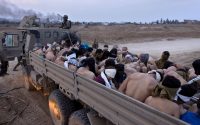Wildfire Approaches Canada’s Largest Oil-Producing Area. Again.
A wildfire was nearing Canada’s largest oil producing region of Canada prompting the evacuation since Tuesday of about 6,600 people from Fort McMurray, Alberta.
The evacuation has evoked fearful memories of a major fire in 2016 that destroyed roughly 2,400 homes and businesses, forced 90,000 people to flee and became the most expensive natural disaster in Canadian history.
The start of wildfire season in Canada follows a record setting year in 2023 when about 45 million acres of forest burned, a huge increase from the annual average of 6.1 million.
Unusually large fires spanned the country with choking smoke from fires in Quebec filling the skies of Eastern Canada and filtering down and degrading air quality down the eastern seaboard of the United States.
Last week federal officials said that prolonged dry conditions in Alberta and British Columbia have set up a potentially dangerous wildfire season in those areas as well as to the north.
This week’s evacuation order was one of several issued in recent days in northern Alberta and neighboring portions of British Columbia, an area hard hit last year by fires and that is in its third year of drought.
On Wednesday morning, the leading edge of the fire was about three miles from parts of Fort McMurray, Alberta Wildfire said that diminishing winds and cooler temperatures were reducing the fire’s severity.
The fire had consumed about 27,000 acres as of Tuesday night. Thick smoke made it impossible for officials to determine its precise size and winds of up to 25 miles an hour forced them to remove fire fighting crews from its leading edge.
Aircraft, including some with night vision systems, were still dropping water on the fire and measures to protect buildings in Fort McMurray were put in place.
Much of the fire, however, is sweeping over terrain that was burned in 2016, reducing the amount of fuel available for the current fire, officials said.
Jody Butz, the fire chief of the Regional Municipality of Wood Buffalo, said during a news conference on Tuesday that he has “a high, high level of confidence” that firefighters will keep the fire out of Fort McMurray.
He said the city has cleared more areas to keep fires at bay than in 2016, and also has larger numbers of firefighters and equipment available.
Two neighborhoods under the current evacuation orders were among the areas burned most extensively in 2016 and then rebuilt.
To avoid the highway chaos that marked evacuations in 2016, officials asked residents of neighborhoods not under evacuation orders to remain in their homes until areas that were in greater danger were cleared.
“Please, please allow these communities to evacuate first,” Chief Jody Butz told residents during a news conference on Tuesday. “It is important that we approach this in a safe and orderly and respectful manner.”
Aleks Mortlock, whose home was destroyed in the 2016 fire, told the CBC, Canada’s public broadcaster, that his earlier experience did not make Tuesday’s evacuation any easier.
He said that he has “the same anxiety, same things going through your mind, and this time, I have kids to worry about.”
Mr. Mortlock said that his two children who are under the age of six “don’t really understand” the perilous situation the fire had created.
People who had left the area sought shelter as far away as Edmonton, the provincial capital, which is about 280 miles south.
Another wildfire in the region near Fort Nelson, British Columbia, has led to the evacuation of about 4,700 people since last weekend. More favorable winds there have aided firefighters in their efforts to control the fire, which had come within about a mile of the community and close to the neighboring Fort Nelson First Nation.
Farther east of Fort Nelson, the entire population of Cranberry Portage, Manitoba, about 700 people, was evacuated because of wildfire. The community in Manitoba’s north has been menaced by fires in the past.
The 2016 fire in Fort McMurray, which came to be known as “The Beast,” led to about 4 billion Canadian dollars in insurance settlements and disrupted production at the oil sands, the United States’ largest source of imported oil.
The last minute evacuation from that fire forced many residents to drive through walls of flame on the only highway south. While fire did not directly cause any deaths among residents or fire crews, two people who were evacuating died in a highway collision.


